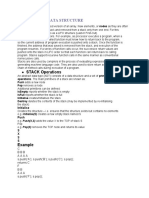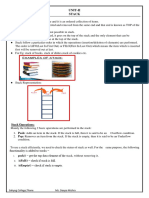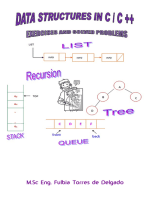Name: Pankaj G. Kabra Class: Mca 3 Year
Uploaded by
maheshonline99Name: Pankaj G. Kabra Class: Mca 3 Year
Uploaded by
maheshonline99NAME: PANKAJ G.
KABRA CLASS: MCA 3 RD YEAR
Stack is a abstract datatype By using which we can stores the values But is characterized by only three fundamental operations:
push, pop and stack top. The push operation adds a new item to the top of the stack, or initializes the stack if it is empty. The pop operation removes an item from the top of the stack. The stack top operation gets the data from the top-most position and returns it to the user without deleting it. The same underflow state can also occur in stack top operation if stack is empty.
import java.util.*; public class Stack { private List items; public Stack(int size) { items = new ArrayList(); } public void push(Object item) { items.add(item);
}
public Object pop() { if (items.size() == 0) throw new EmptyStackException(); return items.remove(items.size() - 1); } public boolean isEmpty() { return items.isEmpty(); } }
You might also like
- What Is A Stack?: Some Key Points Related To StackNo ratings yetWhat Is A Stack?: Some Key Points Related To Stack23 pages
- Introduction to Stacks in Data StructuresNo ratings yetIntroduction to Stacks in Data Structures14 pages
- Stacks: CS 367 - Introduction To Data StructuresNo ratings yetStacks: CS 367 - Introduction To Data Structures28 pages
- Stacks Stacks: Push and Pop An Example Stack OperationsNo ratings yetStacks Stacks: Push and Pop An Example Stack Operations2 pages
- CSC 221 DSA Stack Arrays - Linked List Implementation 27022023 111135amNo ratings yetCSC 221 DSA Stack Arrays - Linked List Implementation 27022023 111135am33 pages
- Abstract Data Type: Jbiet M.Tech. Cse Subject: APSNo ratings yetAbstract Data Type: Jbiet M.Tech. Cse Subject: APS4 pages
- Stack: Presented By: Maritess Tolentino Maricris Z.Alemania Charmaine Delos TriosNo ratings yetStack: Presented By: Maritess Tolentino Maricris Z.Alemania Charmaine Delos Trios22 pages
- School of Biomedical Engineering Jimma Institute of Technology Jimma UniversityNo ratings yetSchool of Biomedical Engineering Jimma Institute of Technology Jimma University11 pages
- Lecture - 2 - Stacks (Envy's Conflicted Copy 2016-03-03)No ratings yetLecture - 2 - Stacks (Envy's Conflicted Copy 2016-03-03)52 pages
- Stacks: Ref.: D.S. Malik, Data Structures Using C++No ratings yetStacks: Ref.: D.S. Malik, Data Structures Using C++13 pages
- Lab Manual: CSC-216 (L6) - Data StructuresNo ratings yetLab Manual: CSC-216 (L6) - Data Structures8 pages
- Introduction To Systems Analysis and DesignNo ratings yetIntroduction To Systems Analysis and Design33 pages
































































